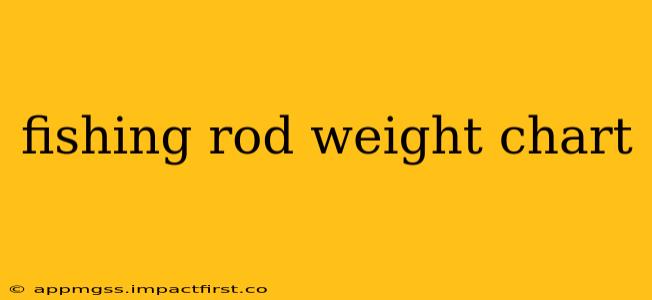Choosing the right fishing rod can feel overwhelming with all the different weights, powers, and actions to consider. This comprehensive guide will help you decipher the often confusing world of fishing rod weight charts and ensure you select the perfect rod for your target species and fishing style. We'll break down the key factors, answer frequently asked questions, and provide practical examples to make your next fishing trip a success.
Understanding the basics of a fishing rod weight chart is crucial for successful fishing. It's about matching the rod's capabilities to the weight of your line and the lures or bait you'll be using. Incorrect matching can lead to broken lines, poor casting, and missed fish.
What Does Rod Weight Mean?
The "weight" of a fishing rod isn't referring to the rod's physical weight in pounds or grams. Instead, it usually refers to its line weight rating, often expressed in pounds (lbs) or kilograms (kg). This indicates the strength of the line the rod is designed to handle. A rod rated for 6-12 lbs means it can handle lines within that weight range effectively. Using a line outside this range could overstress the rod or lead to breakage.
What's the Difference Between Line Weight and Lure Weight?
While related, line weight and lure weight aren't interchangeable. Line weight refers to the strength of your fishing line, while lure weight represents the weight of your lures or bait. A rod's power rating is a better indicator of its ability to handle lure weight, as a more powerful rod can cast and handle heavier lures.
How Do I Choose the Right Rod Power for My Fishing Needs?
Rod power is often described using terms like:
- Ultra-Light: Best for smaller fish like panfish, using light lines and tiny lures.
- Light: Suitable for trout, panfish, and smaller bass, using lightweight lures and finesse techniques.
- Medium-Light: Versatile choice for a variety of species, including trout, bass, and walleye, with a wider range of lure weights.
- Medium: Popular choice for bass, walleye, and other moderate-sized fish, with a good balance of casting distance and sensitivity.
- Medium-Heavy: Designed for larger fish like bigger bass, pike, and muskie, capable of handling heavier lures and stronger fights.
- Heavy: Suitable for very large fish like muskie, stripers, and saltwater species, requiring heavy lines and powerful casts.
- Extra-Heavy: Used for extreme situations with very large and powerful fish, requiring substantial line strength and a robust rod.
What is Rod Action?
Rod action describes how the rod bends under pressure. It's crucial for determining how the rod will perform when casting and fighting fish. Common actions include:
- Fast Action: Bends primarily in the top third of the rod, providing a powerful and accurate cast.
- Moderate Action: Bends along a larger portion of the rod, offering a good balance between power and sensitivity.
- Slow Action: Bends significantly throughout the entire rod, ideal for sensitive presentations and absorbing shock during a fight.
How Do I Determine the Right Rod Weight for Different Fish Species?
The appropriate rod weight will depend greatly on the type of fish you're targeting. Here's a general guideline:
- Panfish (Bluegill, Sunfish): Ultra-light or light rods (2-6 lb line weight).
- Trout: Light to medium-light rods (4-8 lb line weight).
- Bass (Smallmouth, Largemouth): Medium-light to medium-heavy rods (8-15 lb line weight).
- Walleye: Medium to medium-heavy rods (8-12 lb line weight).
- Northern Pike, Muskie: Medium-heavy to extra-heavy rods (12-20 lb line weight or higher).
What Line Weight Should I Use with My Fishing Rod?
The line weight should generally fall within the range specified on your rod. Using a heavier line than recommended can make the rod too stiff, affecting sensitivity and casting accuracy. Using a lighter line could lead to breakage.
What is the Best Lure Weight for My Fishing Rod?
The best lure weight will depend on the rod's power and action. It's best to match the lure weight to the rod's capabilities, ensuring that it's neither too light nor too heavy.
How Can I Find More Information About Specific Rod Weights?
Always refer to the manufacturer's specifications for your particular fishing rod model. The information provided on the rod itself, packaging, or the manufacturer's website is the most accurate and reliable source for determining the appropriate line and lure weights.
This guide provides a general overview; however, practical experience and understanding your fishing style are also crucial in choosing the best fishing rod. Experimentation and adapting your technique based on the conditions are key to becoming a successful angler.
